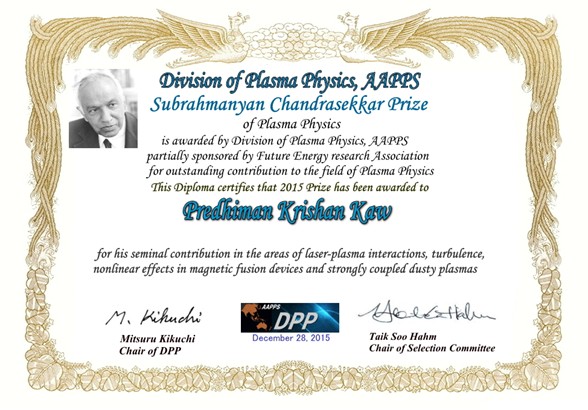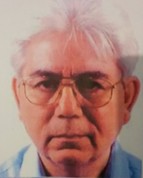Subramanyan Chandrasekhar Prize of Plasma Physics
Prof. Predhiman K. Kaw is selected as Laureate of 2015

January 13, 2016
Association of Asia-Pacific Physical Societies (AAPPS)
Division of plasma physics (AAPPS-DPP)
The Division of Plasma Physics (Chair: Mitsuru Kikuchi) under Association of Asia Pacific Physical Societies (President: Seunghwan Kim) selected Prof. Predhiman K. Kaw of the Institute of Plasma Research as the 2015 Laureate of S. Chandrasekhar Prize of Plasma Physics, which is awarded to a scientist who has made seminal / pioneering contribution in the field of plasma physics.
Citation:For his seminal contributions in the areas of laser-plasma interactions, strongly coupled dusty plasmas, and turbulence, nonlinear effects in magnetic fusion devices.
___________
On the achievement of Prof. Predhiman Kaw

Prof. Predhiman Kaw
(Institute for Plasma Research, Gandhinagar, India)
Prof. PK Kaw is an internationally recognized plasma physicist who has made several outstanding contributions to plasma physics, especially nonlinear laser-plasma interactions, strong coupling effects in dusty plasmas and turbulence and nonlinear effects in magnetically confined plasma.
Professor Kaw’s illustrious scientific career had an early start when he obtained his Ph.D. from the Indian Institute of Technology, Delhi at the young age of 18 yrs. With over 380 research publications in international journals, Prof. Kaw has contributed richly to diverse areas of plasma physics and inspired many new areas of research with his original ideas. After research stints at various laboratories in the world, including the Physical Research Laboratory, Ahmedabad and the Princeton Plasma Physics Laboratory, Princeton, U.S.A. he returned to India for good in 1982 and spearheaded the establishment of a national magnetic fusion program in the country. As the founder Director of the Institute for Plasma Research he has played a leading role in putting India’s fusion program on the international map including full membership and participation in the ITER collaboration. As DST Year of Science Chair Professor he continues to be very active in research as well as in mentoring and training the younger generation of plasma physicists in the country.
Appendix 1: We show two important scientific contributions by Professor Kaw:
1. Laser-Plasma Interaction: Professor Kaw is a pioneer in laser-plasma interaction research. He identified and explored this extremely rich area of physics during its infancy. His prolific work in this area in the late sixties and early seventies was quite foresighted and laid the foundations for a new field with applications from inertial fusion to basic plasma physics. He carried out pioneering research on the key interaction processes, including a variety of laser-driven plasma instabilities. Some of these instabilities lead to enhanced absorption, others to enhanced reflection and laser beam filamentation. In today’s table-top high intensity laser and massive fusion laser experiments, these are the building blocks that are aiding our understanding of the underlying physical processes. Professor Kaw discovered several new basic effects, such as light beam trapping as reported in his 1973 paper entitled “Filamentation and Trapping of Electromagnetic Radiation in Plasmas” in which he obtained a variety of elegant analytic and numerical solutions depicting light filaments and light trapping in a plasma as nonlinear equilibrium states arising from the interaction of the light beam with the plasma. Many of these states were subsequently verified in numerical simulations and observed in high power laser experiments.
2. Strongly-coupled dusty plasmas: Professor Kaw’s highly cited 1998 paper on “Low frequency modes in strongly coupled dusty plasmas” was truly ground breaking in that it opened the door to at least two major lines of research: (1) the existence of a transverse acoustic wave, which is impossible in most other kinds of plasmas and therefore something most theorists would never have imagined, and (2) importing from the statistical physics literature for fluids a new theoretical approach for plasmas with strong Coulomb coupling, namely the Generalized Hydrodynamics Framework. The ideas in this paper were a very substantial step forward, and they have since been experimentally validated. This paper remains an inspiration for many experimenters, and has served as a foundation for many subsequent papers in the field. Many of the leading theorists in the field of strongly coupled plasmas continue to rely on the Generalized Hydrodynamics method developed in this paper as a starting point for their own theories.


